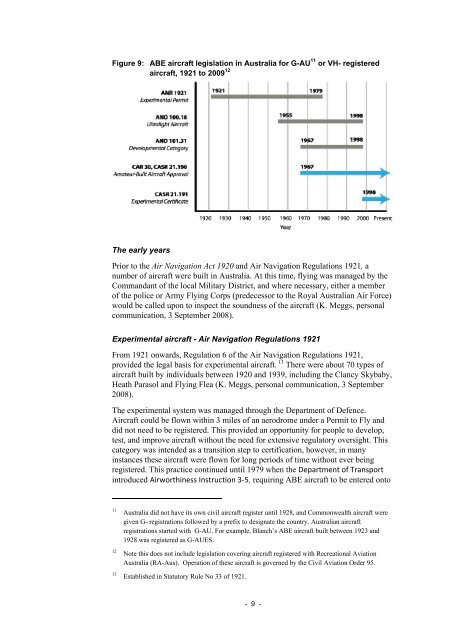Amateur-built and experimental aircraft - Australian Transport Safety ...
Amateur-built and experimental aircraft - Australian Transport Safety ...
Amateur-built and experimental aircraft - Australian Transport Safety ...
You also want an ePaper? Increase the reach of your titles
YUMPU automatically turns print PDFs into web optimized ePapers that Google loves.
Figure 9: ABE <strong>aircraft</strong> legislation in Australia for G-AU 11 or VH- registered<br />
<strong>aircraft</strong>, 1921 to 2009 12<br />
The early years<br />
Prior to the Air Navigation Act 1920 <strong>and</strong> Air Navigation Regulations 1921, a<br />
number of <strong>aircraft</strong> were <strong>built</strong> in Australia. At this time, flying was managed by the<br />
Comm<strong>and</strong>ant of the local Military District, <strong>and</strong> where necessary, either a member<br />
of the police or Army Flying Corps (predecessor to the Royal <strong>Australian</strong> Air Force)<br />
would be called upon to inspect the soundness of the <strong>aircraft</strong> (K. Meggs, personal<br />
communication, 3 September 2008).<br />
Experimental <strong>aircraft</strong> - Air Navigation Regulations 1921<br />
From 1921 onwards, Regulation 6 of the Air Navigation Regulations 1921,<br />
provided the legal basis for <strong>experimental</strong> <strong>aircraft</strong>. 13 There were about 70 types of<br />
<strong>aircraft</strong> <strong>built</strong> by individuals between 1920 <strong>and</strong> 1939, including the Clancy Skybaby,<br />
Heath Parasol <strong>and</strong> Flying Flea (K. Meggs, personal communication, 3 September<br />
2008).<br />
The <strong>experimental</strong> system was managed through the Department of Defence.<br />
Aircraft could be flown within 3 miles of an aerodrome under a Permit to Fly <strong>and</strong><br />
did not need to be registered. This provided an opportunity for people to develop,<br />
test, <strong>and</strong> improve <strong>aircraft</strong> without the need for extensive regulatory oversight. This<br />
category was intended as a transition step to certification, however, in many<br />
instances these <strong>aircraft</strong> were flown for long periods of time without ever being<br />
registered. This practice continued until 1979 when the Department of <strong>Transport</strong><br />
introduced Airworthiness Instruction 3‐5, requiring ABE <strong>aircraft</strong> to be entered onto<br />
11 Australia did not have its own civil <strong>aircraft</strong> register until 1928, <strong>and</strong> Commonwealth <strong>aircraft</strong> were<br />
given G- registrations followed by a prefix to designate the country. <strong>Australian</strong> <strong>aircraft</strong><br />
registrations started with G-AU. For example, Blanch’s ABE <strong>aircraft</strong> <strong>built</strong> between 1923 <strong>and</strong><br />
1928 was registered as G-AUES.<br />
12 Note this does not include legislation covering <strong>aircraft</strong> registered with Recreational Aviation<br />
Australia (RA-Aus). Operation of these <strong>aircraft</strong> is governed by the Civil Aviation Order 95.<br />
13 Established in Statutory Rule No 33 of 1921.<br />
- 9 -

















